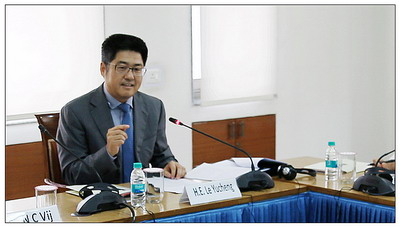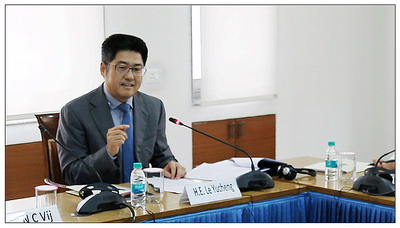Distinguished guests,
Ladies and Gentlemen,
Good morning! It gives me great pleasure to come to Vivekananda International Foundation (VIF), a world renowned think tank, and see so many heavy weight figures and familiar faces. I am a loyal reader of your publications and find them inspiring and thought-provoking. You have extensive exchanges with Chinese think tanks and scholars and have done a lot to advance China-India relations. I wish to commend your efforts and contribution, and hope you will keep up the good work.
VIF is named after Swami Vivekananda, so I would like to begin my remarks today by quoting a line from Vivekananda, “Relationships are more important than life, but it is important for those relationships to have life in them.” I can’t agree more and I think the relationship between our two countries is now full of life, dynamism and opportunities.
On my way here, it dawned upon me that I’ve been Chinese Ambassador to India for nearly 11 months now. Well, 11 months is a short span in the flow of history or in the context of international relations. But thanks to joint efforts from both sides, the past 11 months have seen tremendous and tangible changes in China-India relations, changes that would be hard to envisage a year ago. Let me illustrate my point by sharing with you a few milestone events that happened in the past year.
1. President Xi and PM Modi met for five times, including their mutual visit.
2. Two Chinese industrial parks in Maharashtra and Gujarat are taking shape.
3. Peace and tranquility have been maintained at the border areas.
4. Nathula pass was opened for Indian Yatris to Kailash Manasarovar.
5. E-visa was launched for Chinese tourists.
6. The Local Leaders’ Forum was set up and first meeting was held.
7. More sister city and State/Province relationships were established.
8. Indian Yoga and Chinese Taichi met in exchange.
The list can be much longer, not to mention the growing mil-to-mil relations, people-to-people exchanges, and contacts between media and think tanks, etc. But it’s already clear that the page has been turned, game changed, and a new chapter opened. There are many new defining features of the new chapter. I wish to summarize the features with 4Ds:
First, breakthrough development. The events I listed above are not small ones or chance event, but real, significant and unprecedented changes. They tell us how far our relations have come from estrangement to engagement, from divergence to convergence, and from possible cooperation to irreversible cooperation. The chemistry between our leaders is a telling example. We still remember how President Xi tried his hand on a legendary Charkha and swung on the typical Gujarati Jhoola with Prime Minister Modi during his visit to India, how the two leaders walked together in the Wild Goose Pagoda in Xi’an, and how Prime Minister Modi opened his Weibo account to communicate with Chinese fans and took the “super selfie” with Premier Li. Those pictures suggest evident chemistry and amazing human touch that were rarely seen before. Take Nathula pass as another example, what used to be a point of military face-off has now been opened up for friendly exchanges and become a path for Indian pilgrims to realize their dream of life, Yatra to Kailash Manasarovar. I personally went to Nathula Pass to welcome the yatris. The opening of the new route is not only significant in a religious sense, but will also promote trade, tourism and personnel exchanges and cooperation.
Second, clear direction. If China-India relations can be likened to a train, the past narrative had an ambiguity as to where the train is headed to. Over the past decades, we did have moments when the relationship showed signs of warming up, but each time we were too much focused on disputes and sensitive issues, neglecting or even curbing practical cooperation and personnel exchanges. And security issues seemed to have the veto power over our relations. As a result, a warming relationship inevitably cooled down and opportunities lost. But now the direction is clear and consensus reached to focus on cooperation and building a closer developmental partnership while properly managing differences and preventing them from affecting the overall relations. By making the pie of cooperation bigger, we will gradually build the reservoir of mutual trust and accumulate necessary conditions for the problems to be addressed. I participated the boundary talks between China and Russia. In the last century, the talks went on for decades without much result, and it was only after the normalization of relations and with growing cooperation and exchanges that we finally resolved the issue. The same spirit applies to our boundary talks. Agreement cannot be reached without basic trust and cooperation. If we even don’t know each other well, how can we make a deal? As I said, the border areas have maintained overall peace and tranquility. This is hard-won result, we have done a lot to make it possible. Yes, we still have and will continue to have differences, but as Foreign Secretary Jaishankar said in his recent speech in Singapore, the direction we are moving should be clear even if much work remains to be done. To build trust and advance cooperation, that’s the direction where our train is headed to.
Third, all-round dynamism. Dynamic participation by all society is crucial if the relationship is to enjoy all-round growth. Unlike the past when China-India relations were mainly driven by government contacts and leadership-level exchanges, now every cell of the society is mobilized to address the familiarity gap and promote cooperation: businesses, localities, media, academics and the general public. There is growing passion in each other and the business community is a major driving force. Business people from both sides are eager to explore the potential of each other’s market. Many Chinese companies, optimistic about the promises the Indian market has to offer, have scaled up their investment in India, among them such well-known brands as Xiaomi, Alibaba and Huawei. Chinese real estate giant Wanda plans to work with Haryana government to build a township in Kharkhoda. The first phase, a cultural and entertainment park, involves US$10 billion investment, and the second, an industrial park, will soon follow. As for local relations, the Local Leaders’ Forum is a good platform, and there is also the mechanism of exchange visits between Chinese governors and Indian Chief Ministers. So a number of Indian Chief Ministers have visited China and every week I receive local delegations from China. People-to-people exchanges have picked up remarkably. The recent story of a Chinese volunteer donating stem cells to an Indian boy suffering from leukemia have moved many people. The recent implementation of e-visa for Chinese tourists is the best footnote of the amity between our people and is warmly received in China. Here I must say that credit should be given to PM Modi for this popular move. In a couple of years, the number of Chinese visitors traveling to India is expected to soar from the current 100,000 and may well exceed one million. With e-visa comes not only more tourists, but also better mutual understanding, greater affinity, more business opportunities and expanding cooperation.
Fourth, deepening multilateral coordination. As the largest developing countries and emerging market economies, China and India have many common language and similar positions on regional and global affairs such as climate change, counter-terrorism and financial reform, and enjoy close coordination on multilateral fora, including the UN, G20, East Asia Summit, BRICS, etc. At the just concluded Ufa Summit, the Shanghai Cooperation Organization (SCO) ratified the resolution on India’s membership process. I am sure that India’s membership will boost the influence of and inject positive energy to the SCO and open a new platform for our unfolding cooperation. China and India are both founding members of AIIB, and its largest and second largest shareholders. The well-know Indian banker Mr. Kamath was appointed President of the BRICS New Development Bank. When I met with him shortly before he left Delhi for the new post in Shanghai, Mr. Kamath voiced his commitment to running the new Bank with new ideas and in a different way so that it will better serve the interests of member states and the developing world. I believe our cooperation in all these institutions and areas will go a long way in shaping the global economic and political order and promoting peace and development in Asia and beyond.
I hope the above 4D features will give you a sense of the all-dimensional and dynamic growth of China-India relations.
History has witnessed the friendly exchanges China and India have enjoyed over the millennium and the mutual support we rendered each other in our struggle for independence and liberation in modern times. During WWII, while fighting for independence, India provided valuable and selfless support for the Chinese people’s anti-Fascist war.
We will not forget the Indian medical team who came to China in the most difficult days of the struggle to care for the wounded and save lives. Among them Dr. Kotnis, who came from an affluent family yet chose to give up the comfort of life for a just cause in a brotherly country. He took root in China and made the ultimate sacrifice. In return, he is respected by a grateful nation and loved by a grateful people.
This year, China will join many other countries in commemorating the 70th anniversary of the end of the World Anti-Fascist War. We hope to draw lessons, pool wisdom and gain strength from the past, cherish peace, and work with India and all countries to usher in a better tomorrow. Profound changes are taking place in the global landscape, and a new order and equilibrium are in the offing in Asia Pacific. China-India relations, with growing breadth and depth, have gone beyond the bilateral scope and are acquiring increasing global significance. As major players, we must take up our due responsibility with a sense of purpose and mission. As ancient civilizations, we can and should leverage our potential and contribute our wisdom to regional and global development. Together, we can make a difference.
Remarks by Chinese Ambassador to Nepal Le Yucheng at Vivekananda International Foundation in New Delhi on Aug 7.



